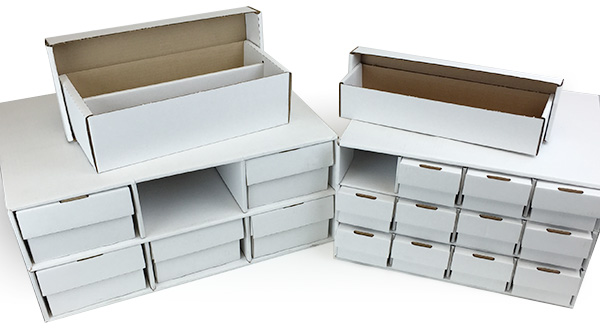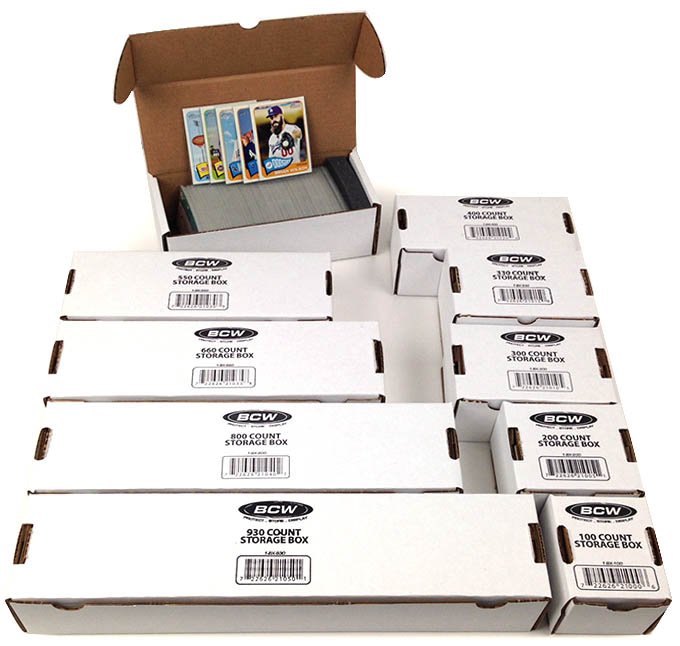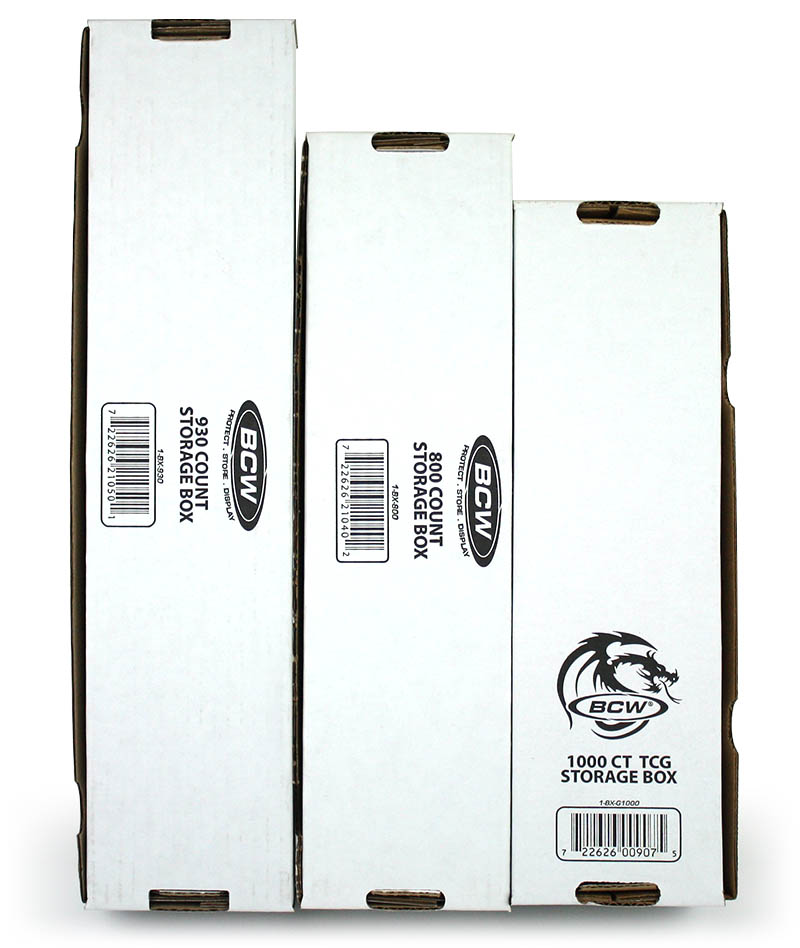Storing Large Card Collections
Do you need to store a large collection of cards? The BCW Card House and Shoe Box House are great solutions.

Do you need to store a large collection of cards? The BCW Card House and Shoe Box House are great solutions.

To store comic books and keep them safe, most collectors place each comic in an archival-safe bag along with a firm backing board to support the comic and protect the edges. The collection is then placed in a “short box”, holding about 150 bagged and boarded comics.
Storing comics has always had a challenge keeping the comics upright when the box is not full. If the is box is completely full, there’s no problem as the comics naturally keep themselves upright with the ends of the box supporting them. However, if the box is only partially full, the comics can topple over like a row of books without a bookend. Collectors can easily solve this problem by placing some comics sideways in the box or using another object as a bookend inside the box. Nonetheless, this issue has always been annoying to collectors.
The BCW Comic Book Bin solves this problem by keeping a partial collection upright at all times. The Bin is made from molded polypropylene panels that are snapped together (see the the second video below). This manufacturing process allows the Bin to have several features not possible with the traditional cardboard short comic box. The Bin uses special Comic Bin Partitions that fit into evenly spaced notches. The Comic Book Bin comes with one Partition. This Partition is movable, so you can use it as a bookend to keep a small collection of comics upright. As your collection grows, you can shift the Partition to the next slot, and so on, until your Comic Book Bin is full. If you want to fill all of the available slots with a Partition, packs of 3 extra Partitions can be purchased separately.
While you may find the Comic Book Bin assembled at your local comic shop, they are normally unassembled, coming in five panels and one partition. The panels snap together to make a sturdy bin. Please review the video below to see the simplest sequence to assemble the Bin.
The Comic Book Bin was designed to hold Current and Silver Age comic books in bags and boards. This includes Current and Silver BCW Archivals (Mylar bags) that are wider than normal polypropylene comic bags. The Bin is also large enough to hold Current or Silver Comic Book Toploaders. BCW Comic Book Dividers also fit under the lid.
Golden Age comics and graded comic books are too large for the Comic Book Bin. While BCW is considering making a Graded Comic Bin, our cardboard Graded Comic Boxes are our best solution for CGC/CBCS slabs at this time. We are also considering a Long Comic Book Bin, but at this time our cardboard Long Comic Boxes or corrugated plastic Long Comic Book Boxes are our best options. For magazines or Golden Age comics, our cardboard Magazine Box is BCW’s best storage solution. If you want to lobby for other products, or suggest product improvements, please comment below. We’re listening!
Although white comic boxes are the standard for protecting and storing comic book collections, there are now several great options for colorful, printed comic book boxes. Until recently, finding a printed comic box was rare. A Little Shop of Comics in New Jersey had the Marvel box seen below in their collection. This Marvel Comic Book Collection Box was offered by the Collectors Marketing Corp. in 1989.

BCW Supplies now prints several designs of comic book boxes. These are all based on the BCW Short Box which can hold 150-175 bagged and boarded comic books and are made from a strong cardboard with double thickness on the ends and bottom of the box.
BCW produces a full line of printed comic boxes. We not only use original designs, but also collaborate with publishers to make boxes based on their properties. We continue to add more designs, so make sure to check the full list of BCW printed Short Comic Boxes.
In our continuing effort to provide you with the highest quality, most cost effective hobby supplies, we made some improvements to the BCW Short Comic Box and Long Comic Box. We have improved the design so they fold together easier and the corners are clean and square. This was accomplished by changing the corrugated double-wall construction from a combination of B and C flutes to a combination of B and E flutes. Additional benefits of the new designs are that bundles of the new boxes occupy less space, and the E flute on the outer wall provides for a much smoother surface.
Prior to implementing the design change, we ran two separate tests using samples of the BCW Short Comic Box in both configurations. Below are the results of those tests.
| Original Design | Flute | Sample A | Sample B |
| ECT | B/C Flute | 62 kN/m | 51 kN/m |
| Mullen | B/C Flute | 241 psi | 250 psi |
| New Design | Flute | Sample A | Sample B |
| ECT | B/E Flute | 63 kN/m | 51 kN/m |
| Mullen | B/E Flute | 245 psi | 253 psi |
The ECT, or Edge Crush Test, is a laboratory test method that is used to measure the cross-direction crushing of a sample of corrugated paperboard. It gives information on the ability of a particular board construction to resist crushing and is expressed in kilonewtons per meter (kN/m).
The Mullen test is used to measure the bursting strength of corrugated paperboard and is usually expressed in pounds per square inch (psi). Mullen tests are performed for each side of the paperboard, and the bursting strength is expressed as the average of both sides.
As you can see from the test results above, there is very little difference between the flute combinations in terms of edge crush or burst strength which is why we decided to take advantage of the benefits of the new design.
We are also adding UPC codes to each of our boxes, including the Short Comic Box and Long Comic Box, to support our customers who have point-of-sale systems, and for those who have integrated systems for warehouse, shipping, and receiving applications. Easy to follow instructions for the assembly of the Short Comic Box and Long Comic Box are now printed on the bottom panel and are hidden from view once the boxes are constructed.
BCW offers numerous sizes of boxes to store collectible trading cards. The boxes are named by numbers, implying they can store that many cards. An example is the BCW 930 Count Box – its title implies it holds 930 cards, however the description claims it holds 825 cards. So why do BCW box names not match what the boxes actually hold? Is there a system to help collectors understand the box naming system vs. the actual box quantity amount?
This is a frequently asked question at BCW Supplies. To understand the answer, a brief history lesson in baseball card collecting is needed. Between 1956 and 1981, Topps was the only manufacturer of baseball cards and they used an 18 point card stock. In 1981, the MLB added 2 more licensees which were Donruss and Fleer. By 1989, The Upper Deck Company, Score, and other brands started emerging. With competition came innovation and card companies started making cards with a little heavier card stock and UV coating which made them a couple of points thicker. One manufacturer of football cards, Action Packed, even started embossing their cards. Then, the card manufacturers started making thicker “premium brands” of trading cards and adding pieces of memorabilia to some of the special cards, usually referred to as inserts.
So, the answer is that, for the period between 1956 and 1989, cards were approximately 18 points thick (18/1000th of an inch) and the boxes were originally designed for these cards. As your cards might be thinner or thicker than 18 points, the card box will hold more or less depending on your situation.

The bottom of most BCW boxes describes their size.
The 1000 Count TCG Card Storage Box is sized to hold 1000 game cards, such as Magic: The Gathering (MTG), Pokémon, and KeyForge. These gaming cards on a pressed, glossy paper that’s thinner than traditional sports cards. A MTG card is about 11 points thick (11/1000th of an inch), while a 1980’s Topps baseball card is about 18 points thick (18/1000th of an inch). BCW card boxes have been named for the cards they were designed to hold. So the 1000 Ct. TCG Box is designed to hold 1000 gaming cards, while the 800 Ct. Box will hold about 800 traditional sports cards. This explains why (in the picture below) the 1000 Ct. Box, designed for the thinner game cards, is actually smaller than the 800 and 930 Ct. Boxes, that were designed for the thicker sports cards.
See all of the BCW Trading Card Boxes. Please refer to the product description to ensure the box you need will protect all of the cards you’re storing.

The bottom of the 930 ct., 800 ct., and 1000 ct. TCG Card Boxes
As the demand for high-end sports cards with autographs and jersey patches increased, the price of the cards increased. This opened an opportunity for creative sports card enthusiasts, with the know-how of modern internet tools, to create case breaking.
What’s case breaking? While the process varies among the case breakers, the general process is the same. First, an organizer buys a case of cards and offers collectors to buy a spot in a break. This spot may represent a team. For example, the participant may ask for, or through a lottery, get all of the Colts cards from a box of NFL cards. Then the breaker publicly awards the cards to the collectors in a live streaming video process. Lastly, the organizer ships the cards to the collector. In addition to being a fun forum to hang-out (virtually at least) with fellow collectors, case breaking gives the average collector the opportunity to get a valuable card and to chase after cards of the stars or teams that interest the collector most.
An interesting aspect of case breaking is the creative mix of modern media. The process may involve live video streaming, recorded videos, chat rooms, shared Google Documents, PayPal and various websites. All of this is molded together by the case breaker to create a social experience.
While I was at the 2014 Industry Summit for sports cards, I asked several respected case breakers and bloggers “who was the first case breaker?”. Kris from KAB, Chad from Firehand Breaks and Sergio from Sports Card Album suggested Chris from CardsInfinity is either the first case breaker, or he would know who started before him.
So here you have it… The response of “who was the first case breaker”, according to Chris at CardsInfinity:
From my understanding Dr. Wax Battle, at The Backstop in New Jersey, was the 1st to video tape some customers breaking boxes when they came in his store. He started doing that once in a while in the year 2006. The camera angles were not the best, but they were entertaining to watch. You got to see first hand what was coming out of the boxes. There were also around 2 or 3 other people that would video tape themselves opening their personal boxes and uploading them to YouTube. Once again these were entertaining, but the camera angles were not the best.
The Doctor Wax Battle Show in 2006
I bought a video camera in March of 2007 and I was going to start video taping my customers open boxes in my store. But the way I would be different, is that I would use the “Vicarious” view. That means I would breeze through the base, just focus on inserts and hits. Also, just show the hands when opening the packs and not the whole person. The videos would be very fast and you could live vicariously through the opening of boxes. Well this took off pretty quickly. I would say in less than a month I had around 20+ breaks on YouTube and all of them were getting 1000′s of views. People would email me all the time, and still do to this day, and tell me that my videos got them back into collecting cards and or that they would watch my videos to see which products to break.
So after about 4 or 5 months of video taping my customers open boxes, I came up with the idea of breaking boxes for customers online. I would create a website, CardsInfinity, and people could order boxes from me. They could either have the boxes shipped sealed or choose to have me open their box and upload the video to YouTube. I thought it would be really cool, if someone could order a box from me and have me open it on YouTube and upload it immediately. This way they don’t have to wait for their box to be shipped and they would get the instant gratification of knowing what they got. Other side benefits were… they would be able to trade/sell cards easier with the viewing audience on YouTube. They would get their cards sleeved, toploaded and teambagged. Plus they could follow the case to see what comes out. If I opened 2 of the 3 Exquisite boxes from a sealed case and nothing major came out, then you would be able to see that. That might encourage someone to try that last box. They know that the case was sealed and that nothing big came out. Versus if you order a single box online, you have no idea where the box came from or anything. For all you know the box could have been purchased off ebay and re-sold back to you. My idea was very high in transparency and I think people took to that pretty quickly.
I remember in the summer of 2007, everyone would call me an idiot and say it would never work. They said no one would let me break their box for them. “That is where all the fun is”, is what they would say. Well it is fun to look back now and see that it did work and that people actually do enjoy watching their boxes get opened for them.
So to answer your question, I don’t know the first person to video tape someone opening a box, but I believe I might be the 1st person to open boxes for other people. It has been a great source of entertainment for me and for others and I really appreciate all the people that have allowed me to do it. Without them, none of this would have been possible.
A Cards Infinity break in 2013